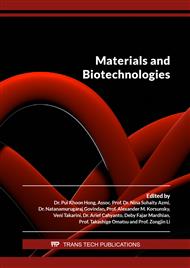[1]
X. Li, Principles of Fuel Cells,, Platin. Met. Rev. 50 (2006) 200–201.
Google Scholar
[2]
M. Rasmussen, S.D. Minteer, Enzymatic biofuel cells : 30 years of critical advancements, Biosens. Bioelectron. 76 (2016) 91–102.
DOI: 10.1016/j.bios.2015.06.029
Google Scholar
[3]
A.T. Yahiro, S.M. Lee, D.O. Kimble, Bioelectrochemistry. I. Enzyme utilizing bio-fuel cell studies, BBA - Spec. Sect. Biophys. Subj. 88 (1964) 375–383.
Google Scholar
[4]
G. Pandey, Biomass based bio-electro fuel cells based on carbon electrodes: an alternative source of renewable energy, SN Appl. Sci. 1 (2019) 1–10.
DOI: 10.1007/s42452-019-0409-4
Google Scholar
[5]
E. Ehara, Y. Toyoda, D. V Johnson, Sago Palm: Multiple Contributions to food Security and Suistainable Livelihoods, Springer Nature, (2018).
DOI: 10.1007/978-981-10-5269-9
Google Scholar
[6]
Y. Sewsynker-Sukai, E.B. Gueguim Kana, Simultaneous saccharification and bioethanol production from corn cobs: Process optimization and kinetic studies, Bioresour. Technol. 262 (2018) 32–41.
DOI: 10.1016/j.biortech.2018.04.056
Google Scholar
[7]
K. Szambelan, J. Nowak, A. Szwengiel, H. Jeleń, G. Łukaszewski, Separate hydrolysis and fermentation and simultaneous saccharification and fermentation methods in bioethanol production and formation of volatile by-products from selected corn cultivars, Ind. Crops Prod. 118 (2018) 355–361.
DOI: 10.1016/j.indcrop.2018.03.059
Google Scholar
[8]
Q. Lang, L. Yin, J. Shi, L. Li, L. Xia, A. Liu, Co-immobilization of glucoamylase and glucose oxidase for electrochemical sequential enzyme electrode for starch biosensor and biofuel cell, Biosens. Bioelectron. 51 (2014) 158–163.
DOI: 10.1016/j.bios.2013.07.021
Google Scholar
[9]
Y. Amao, Y. Sakai, Y. Teshima, Photoelectrochemical starch-O2 biofuel cell consisting of chlorophyll derivative-sensitized TiO2 anode and enzyme-based cathode, Res. Chem. Intermed. 42 (2016) 7761–7770.
DOI: 10.1007/s11164-016-2661-1
Google Scholar
[10]
G.L. Miller, Use of Dinitrosalicylic Acid Reagent for Determination of Reducing Sugar, Anal. Chem. 31 (1959) 426–428.
DOI: 10.1021/ac60147a030
Google Scholar
[11]
A.K. Kumar, B.S. Parikh, L.Z. Liu, M.A. Cotta, Application of Natural Deep Eutectic Solvents in Biomass Pretreatment, Enzymatic Saccharification and Cellulosic Ethanol Production, Mater. Today Proc. 5 (2018) 23057–23063.
DOI: 10.1016/j.matpr.2018.11.035
Google Scholar
[12]
A. Blanco, G. Blanco, Enzymes, in: Med. Biochem., Academic Press, 2017: p.153–175.
Google Scholar
[13]
Y. Hui, X. Ma, F. Qu, Flexible glucose/oxygen enzymatic biofuel cells based on three-dimensional gold-coated nickel foam, J. Solid State Electrochem. 23 (2019) 169–178.
DOI: 10.1007/s10008-018-4099-4
Google Scholar
[14]
Z. Kang, Y.H.P. Job Zhang, Z. Zhu, A shriveled rectangular carbon tube with the concave surface for high-performance enzymatic glucose/O 2 biofuel cells, Biosens. Bioelectron. 132 (2019) 76–83.
DOI: 10.1016/j.bios.2019.02.044
Google Scholar
[15]
M. Kim, Y. Kwon, Y. Ahn, Paper-based mediatorless enzymatic microfluidic biofuel cells, Biosens. Bioelectron. 190 (2021) 113391.
DOI: 10.1016/j.bios.2021.113391
Google Scholar
[16]
M. Tominaga, K. Kuwahara, M. Tsushida, K. Shida, Cellulose nanofiber-based electrode as a component of an enzyme-catalyzed biofuel cell, (2020) 22120–22125.
DOI: 10.1039/d0ra03476b
Google Scholar
[17]
X. Li, D. Li, Y. Zhang, P. Lv, Q. Feng, Q. Wei, Encapsulation of enzyme by metal-organic framework for single-enzymatic biofuel cell-based self-powered biosensor, Nano Energy. 68 (2020) 104308.
DOI: 10.1016/j.nanoen.2019.104308
Google Scholar



